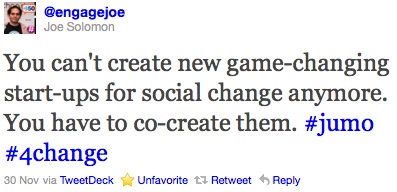My latest contribution to the Stanford Social Innovation Review is now up – you can check out the blog and conversation on the SSIR opinion blog, or read it reposted below.
—–
I recently posted about Jumo with reflections, notes from my experience using the new platform, and questions – this post has also generated a great deal of valuable conversation in the comments (over 70 thoughtful comments so far). One response on twitter from my great friend and colleague, Joe Solomon, has stuck with me and kept me thinking: “You can’t create new game-changing start-ups for social change anymore. You have to co-create them.” And I really couldn’t agree more!
3 Core Elements to Co-Creation for Change
Co-creation is, like many other things, a word rising in standing on the buzzword list. In this case, for this conversation, co-creation is used generally to touch on issues of access and engagement, and collaboration. In each element below, it’s framed slightly differently to match the context, but is always centered on the need, as Joe shared above, to operate outside of silos.
I’ve tried to keep the 3 Elements below to brief conversation starters as I think they all could go on into lengthy pieces on their own. I hope you’ll join the conversation with your feedback and comments about each one, and share additional elements and reflections on co-creation!
On & Offline Engagement
Online is great for organizing. Whether you’re using social networks, or other shared spaces online, the social web is where you can find others, figure out the actions you want to take, spread news and information, promote the actions, and even stream media/data while taking the action. But the action, the real social change, is offline. There’s a great post on the Case Foundation blog that covers some great examples and shares, “Although activism may not look the same, it’s no question from these examples that social media and social networks can be used to motivate the masses into action, whether it be physical or monetary.”
The key is making the connection.
First, ensuring that there are opportunities to engage and participate both on and offline (especially in the promoting and sharing) can increase participation and ultimately feet in the streets. Most organizations, campaigns, and even companies get this and are trying to make toolkits, letters, and even posters than be shared at events or via Twitter, wherever people are.
Secondly, co-creation of a new organization, a new campaign, or a new tool can’t happen if the links between on and offline aren’t clear – if someone shows up in person to an event or planning meeting, they need to know where they can continue engaging online before the next offline event takes place. And the same goes for those who may be following or actively inputting to your work via the web – they should know how to join you, or join with other members, offline to continue building.
For & Non Profit Inclusion
Making social change is not reliant on a tax exempt status. Platforms that put change in front of donations enable co-creation of both impact and of other new organizations or tools. Co-creation, at least in my opinion, works best when there’s possibility for all kinds of organizations, groups or individuals to collaborate; and, likewise, when there are options for different funding streams, even when funding isn’t defined by $.
When we (those working in the nonprofit sector) presuppose that only those with the “nonprofit” status are eligible for investing in a better future, we do all of our communities a disservice. If we really want to change the world, and if we believe there are some for-profit groups that need to change in order for our vision of the future to be realized, then let’s invite them to the table, to take a stake in change, and to co-create a path towards that vision.
Organization & Individual Changemakers
Co-creating new tools, campaigns, organizations or opportunities for social change requires certain opportunities: to be able to form teams, a place/way to showcase ideas, creating a shared vision, and opportunity to communicate across the group/network. Having an organization isn’t a requirement for participation in any of those. It should not matter whether I work for a nonprofit, or if I work at all. If I have an idea to change the world, I should be just as welcome and have equal access to the spaces where I can share the idea and find others to help me make it come to life.
But, that’s just what I think – how do you feel? Looking forward to your ideas!


Amy, I am a little confused.
On the one hand, my reading take away is co-creation is about providing opportunities for expansion by a broader audience the ideas, message, advocacy, fundraising, or capabilities of some initiative regardless of what company, group, or organizational affiliation contributing individuals are associated with. On the other hand it seems like something bigger than that. The former strikes me as a group of folks creating a condition for something to grow and build from. I like that and let me know if my takeaway is in line with some of your thoughts here. That being said, there also seems to be a “Co-creation” that is something a little different:
“Co-creating new tools, campaigns, organizations or opportunities for social change requires certain opportunities: to be able to form teams, a place/way to showcase ideas, creating a shared vision, and opportunity to communicate across the group/network.”
This strikes me as the building or co-creation happening at a higher level, at the level of defining what needs to be done, rather than empowering others to build on what has been defined. Also, my read of Joe’s tweet fits this higher level as well.
Sharing some thoughts back to check some understandings.